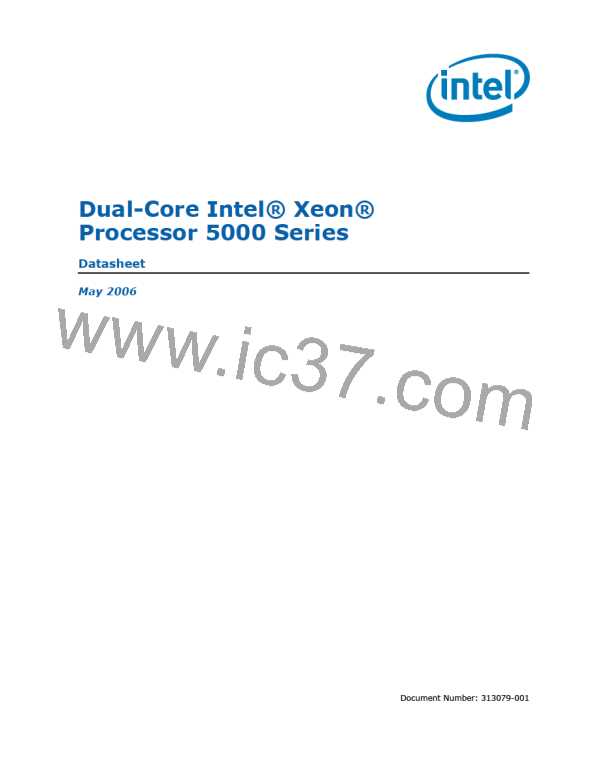Signal Definitions
Table 5-1.
Signal Definitions (Sheet 6 of 8)
Name
Type
Description
Notes
PWRGOOD
I
PWRGOOD (Power Good) is an input. The processor requires this signal to be a clean
indication that all processor clocks and power supplies are stable and within their
specifications. “Clean” implies that the signal will remain low (capable of sinking
leakage current), without glitches, from the time that the power supplies are turned
on until they come within specification. The signal must then transition monotonically
to a high state.PWRGOOD can be driven inactive at any time, but clocks and power
must again be stable before a subsequent rising edge of PWRGOOD. It must also
meet the minimum pulse width specification in Table 2-15, and be followed by a
1-10 ms RESET# pulse.
2
The PWRGOOD signal must be supplied to the processor; it is used to protect internal
circuits against voltage sequencing issues. It should be driven high throughout
boundary scan operation.
REQ[4:0]#
RESET#
I/O
REQ[4:0]# (Request Command) must connect the appropriate pins of all processor
FSB agents. They are asserted by the current bus owner to define the currently
active transaction type. These signals are source synchronous to ADSTB[1:0]#.
Refer to the AP[1:0]# signal description for details on parity checking of these
signals.
3
3
I
Asserting the RESET# signal resets all processors to known states and invalidates
their internal caches without writing back any of their contents. For a power-on
Reset, RESET# must stay active for at least 1 ms after VCC and BCLK have reached
their proper specifications. On observing active RESET#, all FSB agents will deassert
their outputs within two clocks. RESET# must not be kept asserted for more than 10
ms while PWRGOOD is asserted.
A number of bus signals are sampled at the active-to-inactive transition of RESET#
for power-on configuration. These configuration options are described in the
Section 7.1.
This signal does not have on-die termination and must be terminated on the
system board.
RS[2:0]#
RSP#
I
I
RS[2:0]# (Response Status) are driven by the response agent (the agent responsible
for completion of the current transaction), and must connect the appropriate pins of
all processor FSB agents.
3
3
RSP# (Response Parity) is driven by the response agent (the agent responsible for
completion of the current transaction) during assertion of RS[2:0]#, the signals for
which RSP# provides parity protection. It must connect to the appropriate pins of all
processor FSB agents.
A correct parity signal is high if an even number of covered signals are low and low if
an odd number of covered signals are low. While RS[2:0]# = 000, RSP# is also high,
since this indicates it is not being driven by any agent guaranteeing correct parity.
SKTOCC#
SMI#
O
I
SKTOCC# (Socket occupied) will be pulled to ground by the processor to indicate that
the processor is present. There is no connection to the processor silicon for this
signal.
SMI# (System Management Interrupt) is asserted asynchronously by system logic.
On accepting a System Management Interrupt, processors save the current state and
enter System Management Mode (SMM). An SMI Acknowledge transaction is issued,
and the processor begins program execution from the SMM handler.
If SMI# is asserted during the deassertion of RESET# the processor will tri-state its
outputs.
2
2
STPCLK#
I
STPCLK# (Stop Clock), when asserted, causes processors to enter a low power Stop-
Grant state. The processor issues a Stop-Grant Acknowledge transaction, and stops
providing internal clock signals to all processor core units except the FSB and APIC
units. The processor continues to snoop bus transactions and service interrupts while
in Stop-Grant state. When STPCLK# is deasserted, the processor restarts its internal
clock to all units and resumes execution. The assertion of STPCLK# has no effect on
the bus clock; STPCLK# is an asynchronous input.
TCK
I
TCK (Test Clock) provides the clock input for the processor Test Bus (also known as
the Test Access Port).
TDI
I
O
TDI (Test Data In) transfers serial test data into the processor. TDI provides the
serial input needed for JTAG specification support.
TDO
TDO (Test Data Out) transfers serial test data out of the processor. TDO provides the
serial output needed for JTAG specification support.
TEST_BUS
Other
Must be connected to all other processor TEST_BUS signals in the system. See the
appropriate platform design guideline for termination details.
66
Dual-Core Intel® Xeon® Processor 5000 Series Datasheet

 INTEL [ INTEL ]
INTEL [ INTEL ]